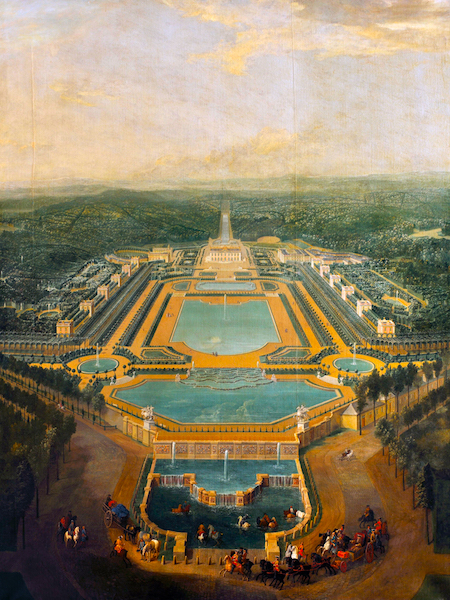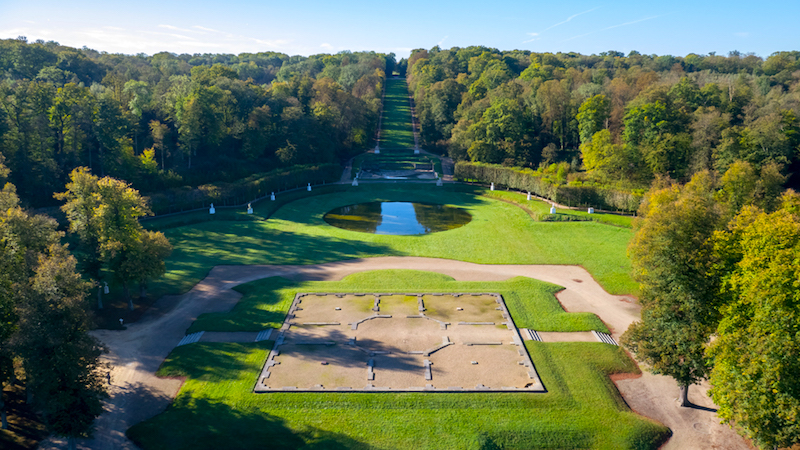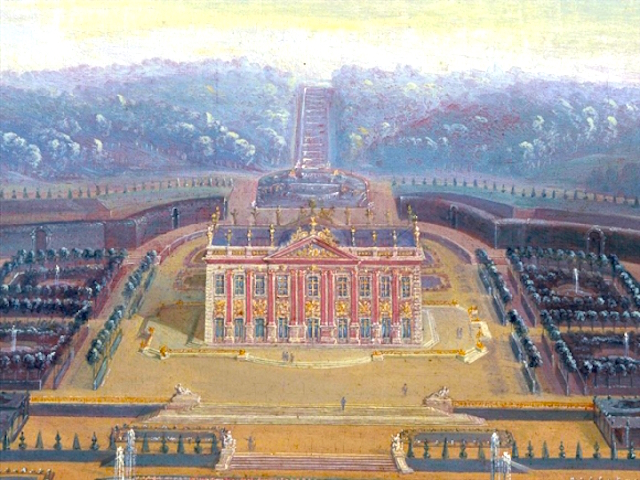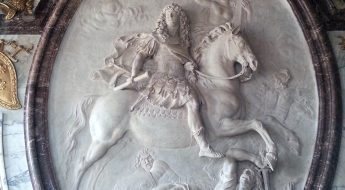It has been said that Louis XIV built Versailles for his court, Trianon for himself, and Marly for his friends.
To that end, Marly consisted of a main house for the King and his immediate family, and 12 guest pavilions. Each pavilion contained 2 apartments, one on each floor. If each guest was married, as many as 48 people could be accommodated. The pavilions faced each other across a water feature in two rows of 6. As the picture below shows, Marly was surrounded by forested hills, which must have given it a pleasing sense of privacy.

The Domaine de Marly as it appeared in 1724. Credit: fr.wikipedia.org.
Apart from the Queen, and later the King’s second wife, Mme de Maintenon, only his brother, Monsieur, and his son, the Dauphin, had the right to accompany the King to Marly without being invited and had their own permanent rooms there. Everyone else, even other members of the royal family and the Princes of the Blood (i.e. the King’s cousins), had to apply for an invitation, either to the King’s private secretary, or directly to the King himself. As the day for a departure to Marly approached, courtiers would murmur, “Sire, Marly?” as the Grand Monarque made his way from his bedroom at Versailles through the Hall of Mirrors to the chapel. If the King invited a lady to Marly, her husband was automatically included, unlike at Trianon, where he was not. Naturally, invitations were highly sought after.
While it may have been a place of refuge and relaxation for the Sun King, his nearest and dearest don’t seem to have had much love for it. In his magisterial work titled simply Versailles,* Ian Dunlop quotes Mme de Maintenon, who complained in a letter that while sitting in the salon of an evening, “On est battu d’un vent qui fait souvenir des ouragans d’Amérique./”One is buffeted by a wind that makes one think of the hurricanes of the Americas.” Louis XIV’s successors, Louis XV and Louis XVI, were not fond of it and only occasionally stayed there to hunt in the surrounding forest.
The main house was not at all large. The floor plan, the footprint of which is all that’s left today (see below), was simple. There was a central, double-height salon lit by ceil-de-boeuf (bull’s eye) windows, from which four 3-room suites radiated outward on each floor. On the ground floor were the King’s own suite, the Queen’s (which Mme de Maintenon later used), Monsieur‘s (which was taken over by his widow after his death), and the Dauphin’s. The suites on the upper floor were reserved for whichever members of the royal family or Princes of the Blood were invited on any given visit. The suites were identically furnished and decorated, except that the furniture of each one was upholstered in a different colour.

The footprint of the main house at Marly today. Credit: fr.wikipedia.org.
As at country house parties elsewhere, the main recreations were hunts, rides, walks, games, practical jokes, amateur concerts and theatricals, and of course gambling. Etiquette was considerably more relaxed at Marly than at any of the other royal residences. Dunlop reports that the King would even throw pellets of bread at the ladies of his family during dinner, and that they were authorized to fire back.
For me, one of the most interesting features of the main house and the guest pavilions at Marly is that their exterior decoration was entirely painted in trompe l’oeil, which is to say that all of the “architectural” details — columns, pilasters, cornices, etc. — were frescoes. This is thought to have been a cost-saving measure. Visitors also commented on how colourful the decoration was.

“Le Château de Marly et les façades en trompe l’oeil” by Pierre-Denis Martin. Credit: National Museum of the Château de Versailles.
Sadly, nothing remains of the buildings at Marly. During the Revolution, it was sold to a businessman who set up a factory on the site. He sold it to Napoléon I, but the Emperor preferred Trianon and eventually gave orders to demolish the residential buildings. Today the grounds and park, which are under the authority of the Château de Versailles administration, can be visited. As far as I can make out, they’re fairly well maintained and probably worth a visit for Versailles enthusiasts. Marly is 7km from Versailles in the commune of Marly-le-roi.
I hope you’ve enjoyed this post about Louis XIV’s lost refuge. I’ll try to put together another post about the gardens at some point in the future. Did you know that Versailles Century has a Facebook page and a gallery on Instagram? Please ‘like’ and follow!
*Most of the details in this post are gleaned from the sub-chapter on Marly in this book. Otherwise, I refer readers to the English or French wikipedia entries on Marly for further reading.


















Leave a Comment